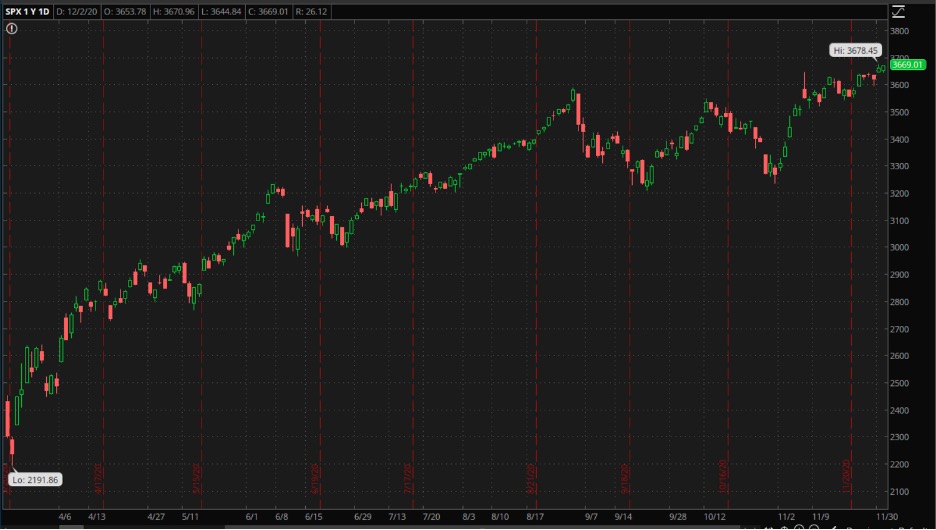More Good News, But the Market Isn't Moving. Why is That?

If you base your view solely on the headlines right now, it is hard to make anything other than a bullish case for stocks. Good news abounds, from the beginning of vaccine distribution to renewed hope for a stimulus bill to pandemic era-low jobless claims numbers released this morning. And yet, the market reaction to all of that has been muted at best. As all the positivity has hit the wire, the S&P 500 has barely moved, gaining less than 1% on the week so far.
So, what gives, and what does it tell us about what to expect as the year ends?
If you take a look at the chart for the S&P 500 since the lows following the initial lockdown back in March, it becomes a little easier to understand why the market is barely moving amidst all this good news:

The index is up over 67% since that low, taking it back above where we began and up to record high territory. All of that has happened as a second and third wave of Covid-19 has hit this country and others, with a dysfunctional Congress that used the election as an excuse to do nothing, and sticky levels of unemployment that haven’t been seen since the Great Depression of the 1930s.
What has happened is that, fueled by free money from central banks, institutional investors have responded to every hint of good news in that time by buying more American stocks. I have no problem with that. Even something as devastating as the pandemic was always going to be over at some point, and it is the market’s job to look forward. The problem is that, as that positive reaction to every bit of good news arrived, there were very few equal retracements when, time after time, the optimism proved to be premature.
That has led to two things being true now, as real good news emerges.
First, everything is priced in. Every time there was any hope of a virus, the market shot up. Every time the unemployment numbers improved slightly, the market shot up. Every time anybody in power said words like “stimulus” and “agreement,” the market shot up. Before long, indices were at levels that could be expected after all the problems were resolved even though there were still problems, so it should be no surprise that there has been such a limited response.
Then there is the “boy who cried wolf” effect to consider. Traders and investors, like all of us, have been told multiple times that all these things were coming, yet here we are, nearing year’s end, and the economy is still weak, stimulus hasn’t been passed, and there is still no vaccine distribution in the U.S. Why should anyone think this time is different?
This week’s “good” unemployment data show 712,000 new unemployment claims last week. Yes, that is better than the 780k expected, but it still means an additional 712,000 Americans lost their jobs just last week. Continuing claims were also down, but that is a marginal reduction in a massive number. The market may be doing okay, but millions of Americans are not.
Many of those are dependent on Congress passing additional help such as extra payments and extension of unemployment payment eligibility just to pay their bills. The latest bipartisan efforts to get something done on that front give hope, but it still faces the obstacle of the “obstructor-in-chief”, Mitch McConnell.
There is real hope for the vaccine, but even before it seemed hellbent on leaving behind as big a mess as possible, this administration’s Covid response was hardly marked by efficiency, and (thankfully in many ways) the FDA is not really known for taking big risks to facilitate speed.
The question “Why isn’t the market going up?” is one that I have heard frequently over the last few days. The simplest answer, and one that applies on two levels, is just that we have heard it all before. That suggests that there is more downside risk than upside during December, so caution is advisable for at least a few weeks.
The views and opinions expressed herein are the views and opinions of the author and do not necessarily reflect those of Nasdaq, Inc.
